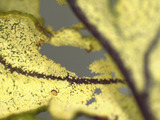
Golden back fern. Back of pinnae.Image credit: Fernando Agudelo-Silva
- Subject:
- Agriculture
- Biology
- Botany
- Forestry and Agriculture
- Material Type:
- Diagram/Illustration
- Author:
- Emily Fox
- Date Added:
- 08/22/2022

Golden back fern. Back of pinnae.Image credit: Fernando Agudelo-Silva
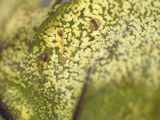
Golden back fern. Back of pinnae.Image credit: Fernando Agudelo-Silva
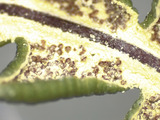
Golden back fern. Back of pinnae.Image credit: Fernando Agudelo-Silva
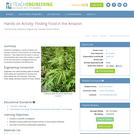
In this activity, the students will investigate a variety of plants and animals common to the Amazon through research. They will determine the plant or animal characteristics that make them edible or useful for the trip and learn to categorize them by comparing similarities and/or differences.
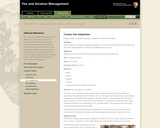
Using this lesson plan students will be more aware of how plants and animals adapt to wildland fire. They will: Discuss the adaptive strategies of plants and animals to survive fire. Observe plants and animals in your local area. Design a plant or animal that is adapted for fire survival.
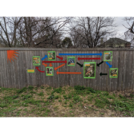
Students will observe organisms in their ecosystem and describe the flow of energy in food webs
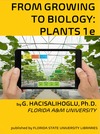
Ready to find out how plants are grown and function? Take a fantastic voyage through plants. From Growing to Biology: Plants 1e brings the latest information for understanding of traditional and modern plant growing, form, and production. Topics covered in 30 chapters include concise and up-to-date ‘big picture’ infographics, student learning outcomes (SLOs), key vocabulary, assessment, as well as identification of 120 species, and more. Moreover, author Dr. G. Hacisalihoglu emphasizes on leaning concepts, binding those concepts together with visuals approach to make learning faster and more memorable.
From Growing to Biology: Plants 1e is packed full of horticultural information that is ideal for both academia and industry growers. It is basic enough that if you are just getting started learning plants, you will be able to catch up. Always remember that practice makes permanent and keep going to take your learning plant bio to new levels.

This activity is a classroom activity to invistigate seeds and plants.
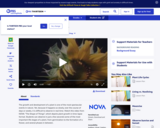
Watching plants grow is like watching paint dry: It happens so slowly that the changes are imperceptible from one moment to the next -- and yet the end results are dramatic. This video segment shows just how amazing plant development can be by depicting various phases of the process using time-lapse photography. Footage from NOVA: "The Shape of Things."
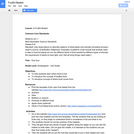
Objectives:
- To help students learn which food is fruit.
- To introduce the concept of healthy food.
- To introduce concept of where food comes from.

Difference between Ephedra and Gnetum 1. Ephedra occurs in warm dry regions as well as at high altitudes while Gnetum occurs in humid tropical and subtropical regions.2. Ephedra plants are generally small and bushy while species of Gnetum are either trees or lianes.3. Ephedra leaves are small and scaly with parallel venation while Gnetum leaves are large with reticulate venation.4. Since the leaves in Ephedra are small and scaly the photosynthetic function is mainly performed by stem. On the other hand, the leaves in Gnetum perform the function of photosynthesis.5. A palisade-like tissue, present in the cortex of Ephedra stem is absent in Gnetum.6. Both Ephedra and Gnetum contain vessels in their secondary wood. However, in Ephedra the vessels contain number of bordered pits on their end walls and in Gnetum a single large pore is present on the end wall of each vessel.7. The secondary growth is of quite normal type in Ephedra while it is abnormal in Gnetum. Many accessory cambia develop to form eccentric rings of vascular tissue in Gnetum.8. The development of male gametophyte in Ephedra is quite similar with that of a typical gymnosperm but in Gnetum it is not like that.9. The pollen chamber in Ephedra is very deep while in Gnetum it is superficial or shallow.10. The embryo sac is monosporic in Ephedra while it is tetrasporic in Gnetum.11. A Tente-pole is present in Ephedra while it is generally absent in Gnetum.12. Before fertilization the female gametophyte is cellular in Ephedra while it is partly cellular and partly free-nuclear in Gnetum.13. The archegonia are present in Ephedra while absent in Gnetum.14. The zygote development in Gnetum is fundamentally different from that of Ephedra.15. The ‘feeder’ is absent in Ephedra while it is present in Gnetum.
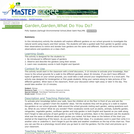
This is a field activity where students explore different types of gardens comparing how they are the same and different.
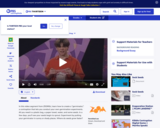
This ZOOMSci video segment teaches you how to germinate seeds in a plastic bag and helps you understand some of the factors that influence the germination process.
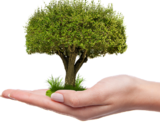
Elementary Science and Integrated Subjects is a statewide Clime Time collaboration among ESD 123, ESD 105, and the Office of Superintendent of Public Instruction. Development of the resources is in response to a need for research- based science lessons for elementary teachers that are integrated with English language arts, mathematics and other subjects such as social studies. The template for Elementary integration can serve as an organized, coherent and research-based roadmap for teachers in the development of their own NGSS aligned science lessons. Lessons can also be useful for classrooms that have no adopted curriculum as well as to serve as enhancements for current science curriculum. The EFSIS project brings together grade level teams of teachers to develop lessons or suites of lessons that are 1) focused on grade level Performance Expectations, and 2) leverage ELA and Mathematics Washington State Learning Standards.

Elementary Science and Integrated Subjects is a statewide Clime Time collaboration among ESD 123, ESD 105, and the Office of Superintendent of Public Instruction. Development of the resources is in response to a need for research- based science lessons for elementary teachers that are integrated with English language arts, mathematics and other subjects such as social studies. The template for Elementary integration can serve as an organized, coherent and research-based roadmap for teachers in the development of their own NGSS aligned science lessons. Lessons can also be useful for classrooms that have no adopted curriculum as well as to serve as enhancements for current science curriculum. The EFSIS project brings together grade level teams of teachers to develop lessons or suites of lessons that are 1) focused on grade level Performance Expectations, and 2) leverage ELA and Mathematics Washington State Learning Standards.
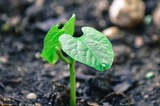
Elementary Science and Integrated Subjects is a statewide Clime Time collaboration among ESD 123, ESD 105, and the Office of Superintendent of Public Instruction. Development of the resources is in response to a need for research- based science lessons for elementary teachers that are integrated with English language arts, mathematics and other subjects such as social studies. The template for Elementary integration can serve as an organized, coherent and research-based roadmap for teachers in the development of their own NGSS aligned science lessons. Lessons can also be useful for classrooms that have no adopted curriculum as well as to serve as enhancements for current science curriculum. The EFSIS project brings together grade level teams of teachers to develop lessons or suites of lessons that are 1) focused on grade level Performance Expectations, and 2) leverage ELA and Mathematics Washington State Learning Standards.
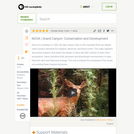
This video segment adapted from NOVA explores the effects of the Glen Canyon Dam on the beaches, wildlife, and vegetation of the Colorado River.
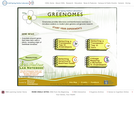
The Greenomes site is part of a laboratory- and Internet-based curriculum to bring college students up to the minute with modern plant research. Plant molecular genetic and genomic research still lags behind medically-oriented research on microbes and higher animals. As a result, there are relatively few lab experiences that expose college-level students to the growing insights into plants offered by genomic biology.
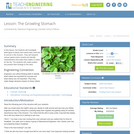
In this lesson, the students will investigate what types of plants and insects they could eat to survive in the Amazon. They will research various plants and/or insects and identify characteristics that make them edible or useful for the trip. The students will create posters and present their findings to the class.
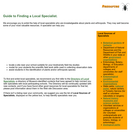
This online article, from Biodiversity Counts, is a guide to finding local specialists who are knowledgeable about plants and arthropods. It includes: an overview of how local specialists can be of help; a link to the Directory of Local Specialists, a list of specialists who have agreed to work with participating schools; a list of additional organizations, with links to Web sites, that are good sources for local specialists; tips on how to find local specialists from Linda Beyt, a middle school teacher in Louisiana and a Biodiversity Counts mentor; and tips for enlisting volunteers by Karen Spaulding, a middle school teacher in Massachusetts and a Biodiversity Counts mentor.